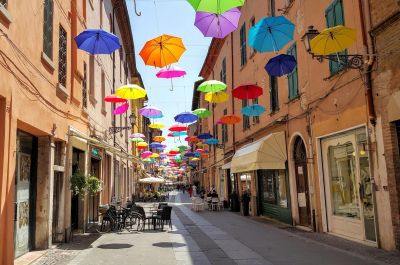La città di Ferrara, nella regione Emilia-Romagna, non è solo un luogo ricco di storia ma ha anche una bellezza unica. Sebbene non sia così frequentata come Bologna e Venezia, Ferrara ha molte ragioni per cui dovrebbe fare parte di un viaggio in Italia. Una struttura molto famosa è il Castello Estense, una fortezza che difese la città, fu costruita nel 1385. La Cattedrale di San Giorgio è un grande esempio di architettura romanica e gotica. L'Addizione Erculea fu un progetto del XV secolo per ingrandire la città. La città è anche conosciuta per le sue sagre, la cucina, e il Buskers Festival, una delle feste di strada più grandi del mondo. La prossima volta che vai in Italia, pensa di trascorrere un paio di giorni a Ferrara. Sarà indimenticabile.
Nestled in the heart of the Emilia-Romagna region, Ferrara is a city that exudes charm, history, and a rich cultural legacy. Often overshadowed by its more famous neighbors like Bologna and Venice, Ferrara offers a unique blend of Renaissance splendor and a relaxed, authentic Italian atmosphere. Whether you're a history enthusiast, an art lover, or simply a traveler seeking a quieter Italian experience, Ferrara has something special to offer.
Ferrara's history is deeply intertwined with the Este family, who ruled the city for over three centuries, transforming it into one of the most important cultural and political centers of the Renaissance. The Este dynasty commissioned some of the greatest architects, artists, and scholars of the time, making Ferrara a hub of artistic innovation and learning.
The city’s golden age began in the 14th century when it became a key court in Europe, attracting talents like the poets Ludovico Ariosto and Torquato Tasso. The Este family’s patronage led to the construction of stunning palaces, churches, and public buildings that still stand today, making Ferrara a UNESCO World Heritage Site.
One of Ferrara’s most iconic landmarks is the Castello Estense, a massive brick fortress surrounded by a moat in the heart of the city. Originally built in 1385 as a defensive structure, it later became the Este family’s residence. Visitors can explore its grand halls, dungeons, and towers, which offer panoramic views of the city.
Another must-see is the Palazzo dei Diamanti, named for its unique façade adorned with over 8,500 diamond-shaped marble blocks. This Renaissance palace now houses the National Picture Gallery and hosts various art exhibitions throughout the year, making it a cultural hotspot in Ferrara.
The Cathedral of Ferrara, or Cattedrale di San Giorgio, is a stunning example of Romanesque and Gothic architecture. Its intricate façade, adorned with statues and reliefs, tells the story of the city's religious and artistic heritage. Inside, visitors can marvel at beautiful frescoes and the grandeur of its medieval design.
Ferrara is often referred to as a "Renaissance city" because of the significant urban planning projects initiated during the Este period. The city’s layout, with its wide streets and harmonious architecture, reflects the ideals of the Renaissance, making it one of the first examples of modern urban planning in Europe.
The Addizione Erculea is a notable urban expansion project commissioned by Ercole I d'Este in the late 15th century. Designed by architect Biagio Rossetti, it doubled the size of the city and introduced a new, symmetrical street plan that became a model for future city developments. Walking through this part of Ferrara is like stepping back in time to the height of the Renaissance.
Ferrara’s cultural scene is as vibrant as its history. The city hosts numerous festivals and events throughout the year, including the Ferrara Buskers Festival, one of the largest street music festivals in the world, attracting performers and spectators from around the globe.
Food lovers will also find Ferrara a delightful destination. The city is known for its delicious cuisine, which includes specialties like cappellacci di zucca (pumpkin-filled pasta), salama da sugo (a rich, spiced sausage), and pasticcio ferrarese (a savory pie filled with pasta and meat). Pair these dishes with wines from the nearby vineyards, and you have a culinary experience to remember.
One of the best ways to explore Ferrara is on foot or by bicycle. The city is flat and compact, making it easy to navigate and discover hidden gems along the way. Stroll through the medieval streets, visit local markets, and enjoy the relaxed pace of life that Ferrara offers.
The City Walls are another highlight, stretching for nine kilometers and encircling the historic center. These well-preserved walls offer a scenic route for walking or cycling, with views of the city on one side and lush green landscapes on the other.
Ferrara is a city that effortlessly combines the grandeur of its Renaissance past with the charm of modern Italian life. Whether you're captivated by its history, architecture, or cuisine, Ferrara promises an unforgettable experience. It's a destination that invites you to slow down, explore, and appreciate the rich tapestry of culture and beauty that defines this Renaissance gem.



